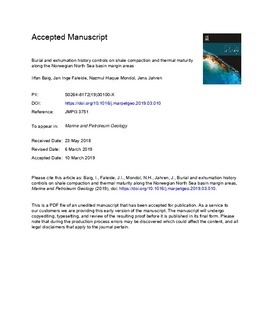| dc.contributor.author | Baig, Irfan | |
| dc.contributor.author | Faleide, Jan Inge | |
| dc.contributor.author | Mondol, Nazmul Haque | |
| dc.contributor.author | Jahren, Jens | |
| dc.date.accessioned | 2019-05-09T07:28:38Z | |
| dc.date.available | 2019-05-09T07:28:38Z | |
| dc.date.created | 2019-03-20T11:52:14Z | |
| dc.date.issued | 2019 | |
| dc.identifier.issn | 0264-8172 | |
| dc.identifier.uri | http://hdl.handle.net/11250/2597042 | |
| dc.description.abstract | The North Sea area has been subjected to significant erosion and subsequent deposition of sediments in the basin margin and deeper basin areas, respectively, during the late Neogene. A large amount of Cretaceous-early Quaternary sediments have been removed below the angular unconformity along the west and southwest coast of Norway and deposited in the huge North Sea Fan at the mouth of the Norwegian Channel. At the same time, a considerable thickness of early Quaternary-Paleocene sediments was also eroded towards the east in the central North Sea and subsequently deposited in the deeper basin areas to the west. This study seeks to estimate exhumation from compaction and thermal maturity based techniques by using sonic velocities of shales/carbonates and vitrinite reflectance data in a large number of boreholes in the central, eastern and northern North Sea. The results indicate no or minor exhumation in the Central Graben and flanking high areas, whereas more than ∼1 km sediments are eroded in the basin margin areas towards the Norwegian coast. More than ∼500 m sediments are eroded in the Egersund Basin and Stord Basin areas. A similarity of exhumation estimates from the Early Cretaceous-Early Miocene shales and Late Cretaceous-Early Paleocene carbonates indicates maximum burial sometime after the Early Miocene in most of the central and northern North Sea areas. However, the maximum burial throughout the North Sea Basin may be diachronous. Seismostratigraphic analysis indicates maximum burial sometime during the Oligocene in the Sorgenfrei-Tornquist Zone area in the eastern North Sea. Maximum burial in the Norwegian-Danish Basin varies from Miocene-Pliocene in eastern parts to early Pleistocene in western parts, whereas sediments are currently at their maximum burial in the Central Graben and southern Viking Graben areas. Restoration of surface elevations to their original position before the onset of erosion indicated large subaerially exposed areas in the Norwegian-Danish Basin and along the southwest coast of Norway. This is also supported by predominantly coastal and/or deltaic environments in the Norwegian-Danish Basin area during the late Neogene. These subaerially exposed areas may be linked to the regional tilting and erosion of the basin margin areas to the east and progressive basinward migration of deposition centres to the west since the Oligocene. The exhumation had significant effects on the petroleum system in the basin margin areas by cooling down the source rock. However, the deeper burial of sediments may also have changed the rheological properties of sediments from more ductile to brittle due to compaction and diagenetic processes which makes them more failure prone during exhumation leading to hydrocarbon leakage or seal failure in case of CO2 injection. | |
| dc.description.abstract | Burial and exhumation history controls on shale compaction and thermal maturity along the Norwegian North Sea basin margin areas | |
| dc.language.iso | eng | nb_NO |
| dc.title | Burial and exhumation history controls on shale compaction and thermal maturity along the Norwegian North Sea basin margin areas | nb_NO |
| dc.type | Journal article | nb_NO |
| dc.type | Peer reviewed | nb_NO |
| dc.description.version | acceptedVersion | |
| dc.source.journal | Marine and Petroleum Geology | nb_NO |
| dc.identifier.doi | 10.1016/j.marpetgeo.2019.03.010 | |
| dc.identifier.cristin | 1686267 | |
| cristin.unitcode | 7452,4,5,0 | |
| cristin.unitname | Petroleumsgeomekanikk og geofysikk (PGG) | |
| cristin.ispublished | true | |
| cristin.fulltext | postprint | |
| cristin.qualitycode | 1 | |
